The culmination of months of yearning ended on a bright sunny morning of October, 2016, a few days after the autumnal Durga puja. That year the rain Gods had smiled during the Puja and the revellers had to go pandal-hopping amidst continuous drizzles and downpours. Remember a similar downpour from my childhood. Otherwise this time of the year usually sees sparkling sunny days with a little bit of morning chill.
As is the norm, the rain loosened the soil, which tumbled down in landslides and mudslides throughout the hills. Mountain rivers and rivulets were in spate. Downstream Manas National Park in lower Assam even had to bear an aberrant flooding. Friends and co-birders, Anshuman and Saurav forwarded harrowing images of landslides from beyond Roing.
All these events had, uncharacteristically, a nonchalant, almost benevolent, reaction in me, so strong was my faith regarding the well-being of my upcoming tour, thanks to my preparations (including a new camera and lens supposedly befitting forest birding in this part of the world!), teammates and accuweather forecast. And what a trip it was!
The team constituted of specialist birder and bird photographer Anupam Nahardeka; a young geologist in a petroleum PSU, Swapnanil Borah; driver, Bitu Das from Dibrugarh, a learned man by himself with a vast experience of porting various birders to myriad sites of Eastern India and then, me, the senile one of the group, supposedly old but yet salivating at any mention of birding in the hills.
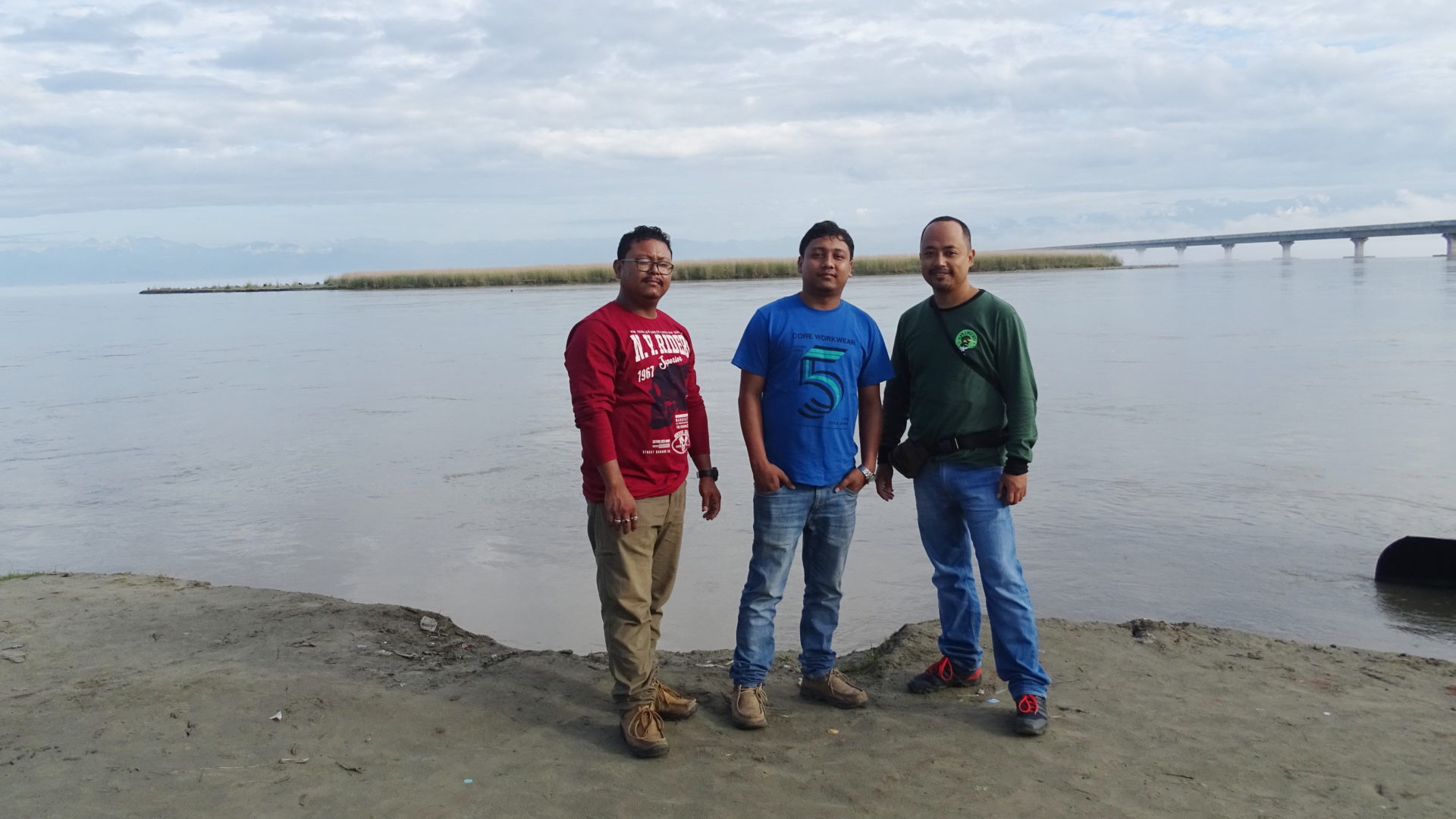
Anupam Nahardeka, Swapnanil Borah & Tridib Hazarika
Day One:
As predicted, the rains stopped a day ahead of our trip. We started from Dibrugarh at about 4:30 am in the morning on 14th of October, Friday. As we sped along the slowly awakening suburbs we espied a flock of slender-billed vultures near Tinsukia. Near and at Dhola we saw many wagtails and shrikes, foretelling a good migration. We reached Dhola ghat at 7:10 am, only to learn that the first ferry will be available at 8:30 am. We passed the time as productively as possible by clicking the riverside scenes, group shots and having a very early lunch. The last was a very good decision in hindsight as birding on an empty tummy is not my ‘cup of tea’. Crunched through delicious ‘boriolas’ and hard boiled eggs.
The ferry started on time and slowly chugged through the lifting river mist. We reached Sadiya ghat an hour later. After disembarking our vehicle and ourselves we chatted with the pilot and his helper who said that the last ferry to leave this ghat is at 4 pm and they will do the honours. Keeping this in mind we entered Sadiya proper where a pleasant surprise awaited me. It was the road. Or simply, the presence of it. Last time I traversed this road, about two and a half years back, there wasn’t actually a road. We had to travel from one pothole to another, through flood-ruined paddy fields and dusty, back-breaking tracts. Okay, I might be exaggerating, but there was actually a road this time, almost half of it laid with pebbles and stones from the mountain riverbeds, in preparation of a future tarmac. Soon we reached the small but bustling town of Sapakhowa on the Assam frontier, a town more resembling in character with an Arunachal locality. Such that, even that widespread malady of ‘Assam-bandh’ has no effects here, so I am told. The customary check-post checking of our ILPs at Santipur gate, courtesy Bituda, and we were off to Arunachal. But not before Anupam purchased a chilled He-man 9000 beer and we partook of the customary ‘one for the road’.
Reached Roing at about 10:30 am. Topped up the fuel tank of our utility vehicle. Our local guide was waiting for us at the Roing market. He is the famed Mr. Ravi Mekola a handsome Idu-Mishmi gentleman of this valley, manager of Coffee house at Mayodia, birding guide and local contact. We alighted and had an insipid cup of tea. Picked up our remaining rations and a generator and we were off. After crossing the placid Deopani river and a short loo break, we entered birding territory. But a word of caution here for other birders. After crossing the Deopani river up to midway to Tiwarigaon, the roadside habitat has been destroyed due to ongoing road contruction. Stopped to try out the lesser parrotbill at its favourite haunt. But to no avail. We didn’t get any response whatsoever. Blaming it on the current disturbance we proceeded in halts. Encountered a flock someway up, populated with white-naped yuhinas, striated yuhinas, yellow cheeked tits, black-throated sunbirds. A silhouetted maroon oriole and an unidentified finch (later turned to be a common rosefinch) were the other finds. The others sighted a distant raptor. Slowly we moved along, enjoying the sunny day. We reached a site which looked good for the Manipur wedge billed babbler and indeed its call was heard there. Ravi played the call and soon it crept up for some furtive views. As we all scrambled to try out some shots, the moment passed by in fractions of seconds. Soon it was gone and it was time for reviewing our shots on our cameras. And lo, behold! There was the skulker, straddling a bush in my camera display. A silent thanks to providence escaped my lips. My comrades were unlucky this time. After a short distance Ravi again stopped and played a call. Now these calls are all greek to me. Anupam informed that it was a long-billed wren babbler, responding from the undergrowth. All of a sudden the little one decided to perch on a roadside parapet, its long bill smeared with mud, whilst it was probably digging delicacies from the ground. And it stayed there for a good many seconds and the air was filled with three cameras in burst mode shutters. It turned this way and that and then flew low across the road to disappear amongst some colocasias. Oh it was a terrific moment. A second exotic lifer in almost as many hours and we had reason to be thrilled.
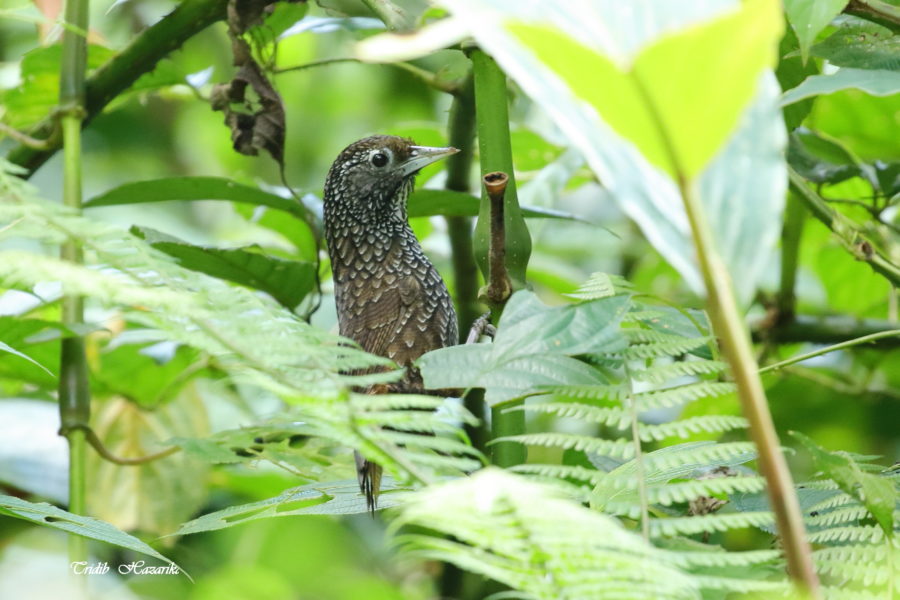
Manipur wedge billed babbler
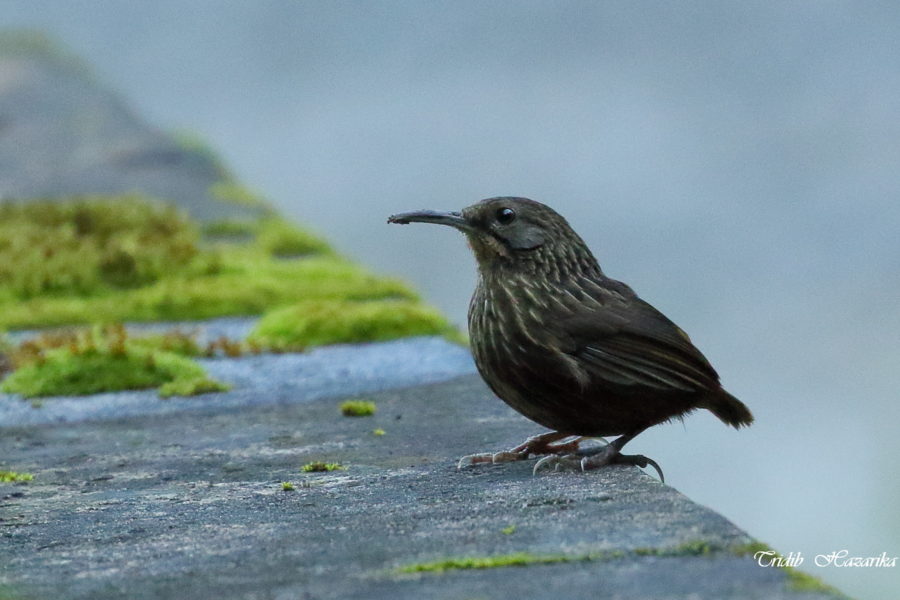
Long billed wren babbler
We reached Tiwarigaon, a village approximately midway between Roing and Mayodia Pass. The roadside tea stall of Didi was a welcoming sight. Didi, an effervescent lady, soon cooked up some instant noodles for us all. My delicate stomach cannot handle any fiery savouries and she had to prepare non-fiery noodles for me all over again.
Soon we were on our way, mostly hiking our way up till daylight sustained. Anupam, dismayed by unsatisfactory shots of the skulker Manipur wedge billed babbler, himself sulked a little. But in this zeal for procuring himself a shot he and Ravi kept up a relentless search.
As light faded and night descended, we boarded our vehicle and went upto the Coffee house without any more halts. Front seater tour leader Anupam must have kept an eagle eye looking out for the crepuscular and nocturnal birds. But I surrendered to the rolling motion of the car and caught my customary forty winks. Woke up and saw the welcoming sight of Coffee house silhouetted in the moonlight. We decided to keep a part of our luggage in our rooms and hastily climbed the stairs. Then we got ready for night birding, attaching flash guns and beamers. We continued our journey beyond Coffee house to Mayodia pass. Two torches held by Anupam and Ravi lighted up the roadside trees and bushes. But no owls or nightjars. Not even a flying squirrel. Turned around to head back to the warmth of our lodge and lo, behold ! There was the owl sitting atop a derelict small outhouse near our lodge. We must have made too dramatic and noisy an entry as the owl promptly turned up its nose and then its tail and stealthily flew off into the darkness, never to be seen again for the remainder of the trip. Sigh! Our experts Anupam and Ravi said it was a mountain wood owl. But as we were climbing the various stairs running up to the upper reach lodge, uphill of Coffee house, Ravi sighted a pair of gleaming eyes. A Nightjar! The bird was sitting on a ledge like rock, on a wet mossy patch. The boggy feeling of the wet moss would have been a detriment otherwise. Gingerly we went as near as practical and started taking photographs, as Ravi shone the torches for illuminating the nightjar. We crept up nearer and it just sat there, with an almost nonchalant attitude. Shutters buzzed and we tried to better our own captures, trying out different combinations of camera settings, such was the nightjar’s benevolence. After what seemed like an eternity, Ravi, who was nearest to the bird suddenly, stood upright yelling, ‘leeches’. And leeches they were; small, medium and large-sized clinging to our clothes and creeping inside them. We hastily stepped down from the elevation, down to the road where we intrepidly inspected our clothes by headlights and torchlights. Ravi was the most infested, followed by Swapnanil, who even dreamt about the blood-sucking parasites later in the night. I escaped with only two clingers. A hilarious end to a glorious sighting!
We trudged into the lodge, starting the small portable generators. As Ravi and Bituda got busy preparing our proteinaceous dinner, the photographers got busy charging up our assortment of batteries and gadgets. The night was quite chilly at about 6° – 7° Celsius. A brilliant moonshine flooded the hills and vales beyond. Tired souls, we gulped down our nightcap rums with a delicious pork-rice supper and called it a night.
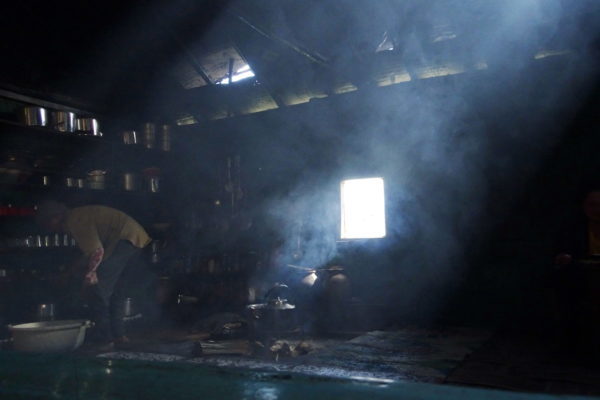
Inside view of a Restaurant
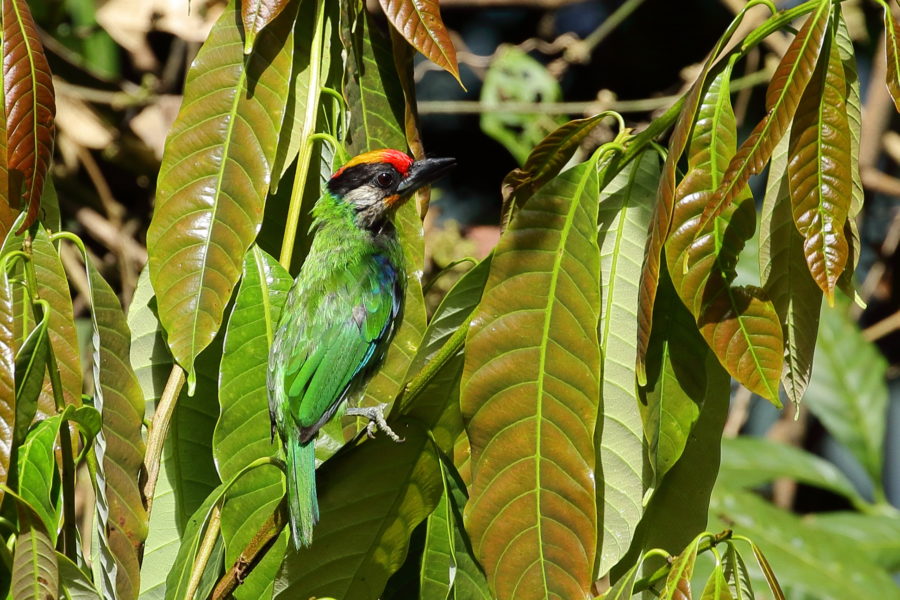
Golden-throated barbet
Day 2:
The second day started a few minutes before 4 am. Anupam and me had shared a room while Ravi and Swapnanil another. Bituda slept alone. Soon Anupam woke up and we got busy, preparing for the day. A cup of lal-chai and biscuits and we were ready for the day. It was about 5 am when we started. The morning chill was perfect for a fleeced jacket. The plan was to go up to the pass, and then beyond the place called 65 (that is 65 km from Roing). I haven’t traversed this road before and looked forward to the journey. No sooner had we boarded our vehicle, that our spotter espied a flock of Manipur fulvettas foraging at eye level on the downside of the road. The soft morning light had lighted up the hill tops and the sky was an azure blue. Not a single piece of cloud above us. I clicked the fulvettas to my heart’s content. Just then all of us saw something crossing the road about a hundred feet ahead. A male Blyth’s tragopan! But it was long gone before we could react. A short distance ahead we encountered a flock of cute black-throated parrotbills. A lifer to me and of much emotional value, I tried out shot after shot only to be dismayed by a strong backlight silhouetting out the bamboos, the habitat of the parrotbill. Nevertheless it was a much sought after lifer for me. Same with Swapnanil, seeking out the accompanying golden breasted fulvettas and a lone yellow browed tit. A flock of grey-sided laughingthrushes crossed the road some distance ahead and I got busy ‘carpet-bombing’ the trees with some shutter bursts. Another lifer. A dried out tree by the road yielded a lone Darjeeling woodpecker. Again a lifer!
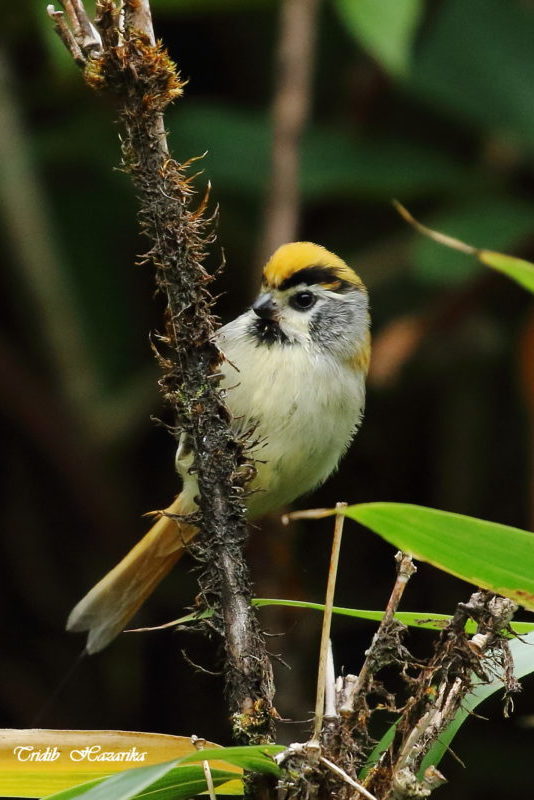
Black throated parrotbill
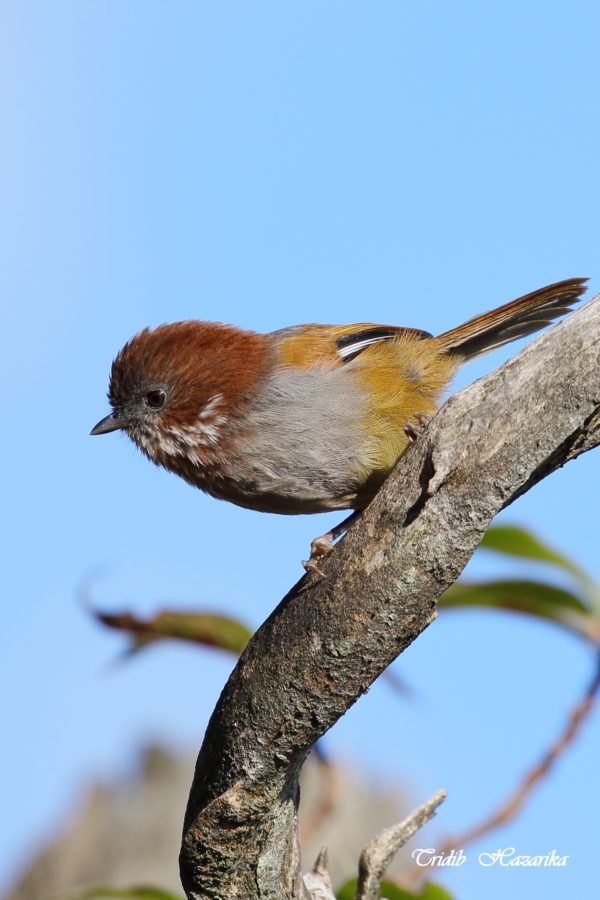
Brown-throated fulvetta
After some similar encounters, we reached the Mayodia pass manned by the signal corps of the Indian Army. Ravi played his player and out popped two bar winged wren babblers from the bushes, very inquisitive and bold, responding in like. We enjoyed their company till it was time to say bye as we had to cover many more grounds. As we stood by a grove at a little lower level, by the road, we saw a frolicking flock of bar-throated sivas, rufous-winged fulvettas and brown-throated fulvettas. The rufous-winged ones were another lifer and we got busy again. Just then I noticed that they were alighting onto our side of the road on the leafless boughs of a dead and fallen tree. We clambered near but to our amazement they just stayed there making typical bird like movements. We surmised that after the recent heavy rains, they too haven’t had their fill of sunshine and so must have been sunbathing. All the more good. The dainties made for some razor sharp pictures. At one time, I gave up clicking them and started making panoramic shots with my compact camera with both the birders and the birds in the frame, with the cottony clouds down in the valley as a backdrop. We decided to have our breakfast there in their company and they said goodbyes by flying through our munching group.
Breakfast consisted of noodles in a cup, hard boiled eggs and boiled, pre-soaked bengal grams. I got greedy and had one egg too many and reaped its repercussions later. I remarked then to Anupam that I was tired from all the excitement and felt satiated. He expressed surprise and said that, nothing doing. The day had just started.
Swapnanil, with Ravi’s help bagged a male white-browed shortwing while Anupam got a beautiful chestnut-headed tesia. Further inquisition for the shortwing yielded no fruitful results. A couple of slender-billed babblers made for another lifer, but not before I was reprimanded by Ravi that my over-enthusiastic movements were scaring the birds. I said a sheepish sorry and tried to mend my ways. My companions got some beautiful shots of the beautiful sibia, very common at this altitude. Downhill the slender billed babbler played truant many a times, as we kept trying for some better (read closer) shots. A flock of yellow-cheeked tits and green-tailed sunbirds enthralled us with really great shots. The day’s events so far made me remark that that I felt like being at a ‘studio-point’ site of north India or down south in Old magazine house at Karnataka and not at a north-eastern site, such was the proximity of the birds.
The natural waterfalls on this stretch of the road were also quite a spectacle by themselves. One encounter various sorts, some rushing over the road in a stream while some fell directly on to the road. Bituda made good use of the latter falls by positioning his car under the falls and getting a free car wash. A female large niltava sat nearby. Quite a few rufous gorgeted flycatchers were also noticed.
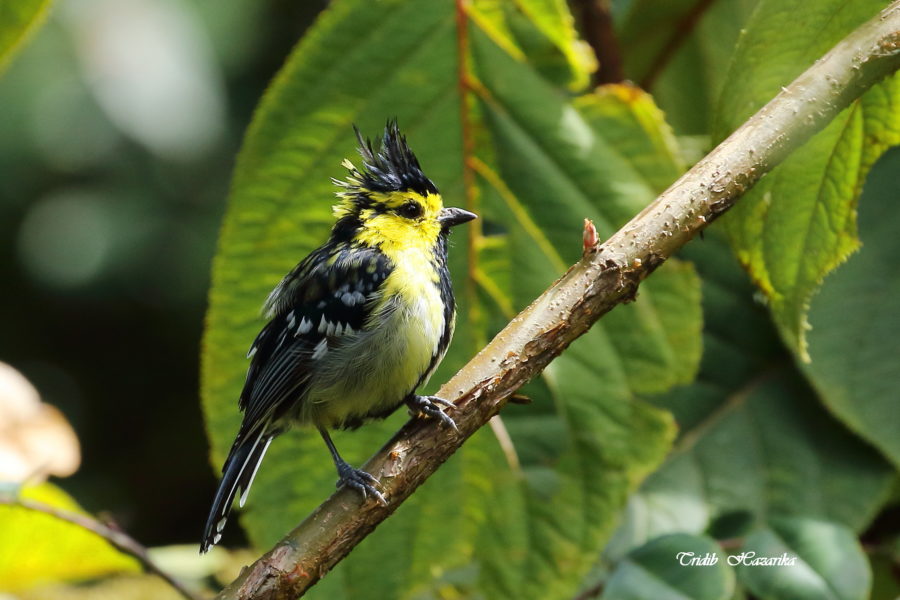
Yellow Cheeked Tit
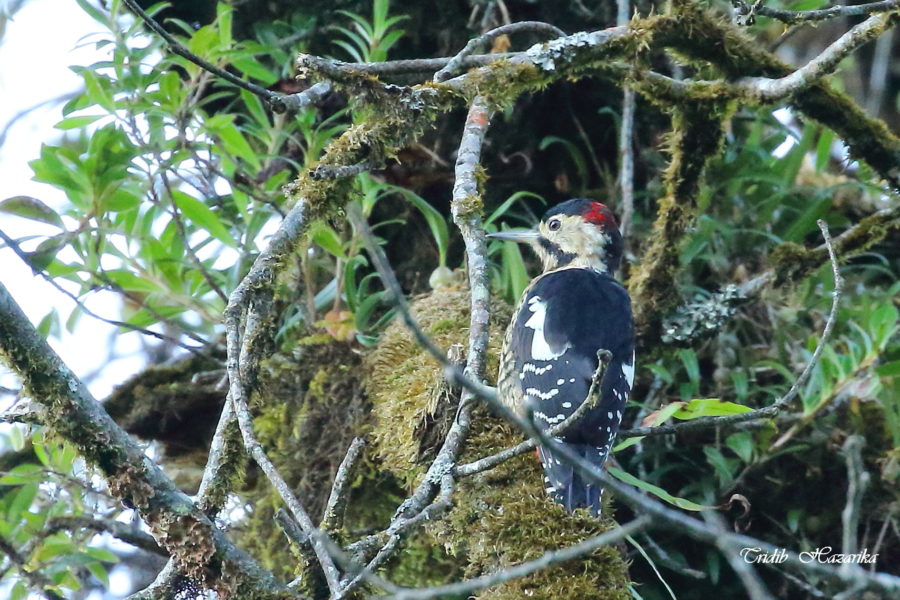
Darjeeling woodpecker
As the sun slid down from its zenith, and the birds rested in the shade, we too decided to take a well earned rest and have our lunch. And what better place for lunch than at 65. We parked at a roadside eatery in the small but relatively bustling hamlet. The eatery had a very local flavour with a smoke-darkened indoor fireplace and a hole in the roof effectively working as a chimney. There was even a mirrored washbasin with cool water from nearby mountain streams. There were a few other patrons having their lunch and sipping beverages. Lunch consisted of leafy vegetables, a cold salad, hot fried pork and tepid boiled rice with raw onions, chillies and lemon slices in abundance. We gorged on our food served by a handsome Mishmi hostess with a stern outlook and a voice to match. After having our fill and the coup-de-grace with paan-tamul / chewing tobacco, we resumed our trek onwards to our lodge.
The trek yielded a gorgeous Tickell’s leaf warbler at the Mayodia pass, foraging nearby and apparently oblivious to our wide eyed stares. As we crossed the pass, a thick, dark cloud enveloped us and we quickly changed our equipment settings to match the conditions. No sooner had we done it, we again encountered the black-throated parrotbill flock and their bosom friends, busy charging at the hapless insects and tender bamboo shoots. Happily we trekked downhill until our column leader Anupam, ever vigilant, put up a clenched fist in the air like a platoon commander signalling his men to stop. All of us stopped and tried hard to listen to whatever had caught his attention. I, at least pretended to listen as, truth be told, most of the avian songs and calls seems all the same to me. “Broadbill!”, he announced. I immediately thought of the commoner long tailed broadbill of the plains when Swapnanil voiced my concerns. ‘No’, Anupam strained, eyes shining with excitement, “it’s a broadbilled warbler”. Ravi tinkered with his player and soon the critter came into view, exposed on a thin stem of bamboo. But the light had already failed and we managed to secure some record shots only.
Hill partridges kept calling below us without any intention of exposing their famed beauty. A Mishmi wren babbler tried to compensate but soon thought otherwise and blended into the fast approaching darkness.
It was a full moon night. ‘Lakhi purnima’ in fact. The bright globe of the moon in the cloudless night chased away most of the twinkling stars and also all the nightly birds as well. Over a hot cup of invigorating red tea, looking over the stunning vista from the verandah of the Coffee house, we could see the lights from the plains far away. We could make out the far away lights to be apparently from Sapakhowa and Dhola, along the river. Conversations ranged from the mundane to the eclectic and I would have gone on lecturing to my rapt audience of Bituda and Swapnanil, had Anupam not intervened to say that it was time for night birding. Trudged along dutifully, and the car kept making long loops in the road. But the owls had taken the weekend off.
Tired and with a slight forearm sprain, I requested the others to complete the day’s sighting list and the kind souls readily consented. A local hunting party gave us company, amused by our antics. I looked out from the verandah once again soaking in the sights nature had bestowed on this place and felt a deep sense of fulfilment and gratitude for just being there, in that moment surrounded by friends, away from home, but strangely still at home.
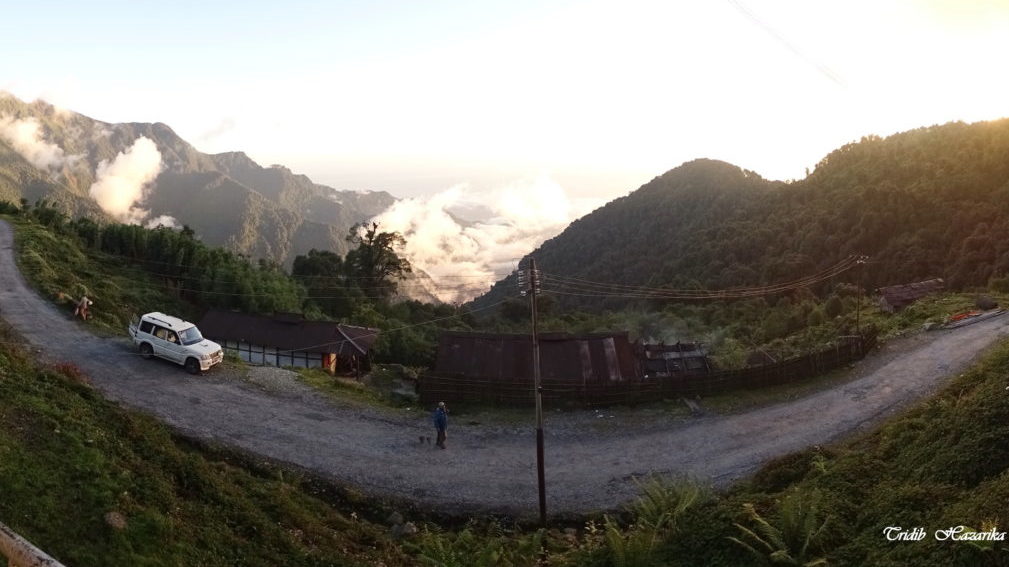
Panoramic view from Cofee House
Day 3:
The last day of the short trip began like the other days. We packed our baggage and bid adieu to Coffee house. Ravi tried out last evening’s site for the Mishmi wren babbler but got no response. We heard the call of a Ward’s trogon from quite a distance on the upside of the hill. Our experts tried their best to elicit a positive response but the trogon had other ideas. And this trip became my third consecutive trip without a glimpse of the ‘ghost of the forest’. Feeding-flocks were seen, consisting of bar-throated sivas, Manipur fulvettas, streak throated yuhinas, green-tailed sunbirds, lemon-rumped warbler, ashy throated warbler etc. The call of a shortwing was captured by Anupam (that too from within the moving vehicle, crunching over the pebbles!) and we alighted. It turned out to be white browed shortwings who condescend to give an appearance but alas, we were too sluggish to grab the opportunity and had to be contended with shots of vent and rump or lurking out-of-focus female of the species, behind the undergrowth.
Breakfast was served by the road on a small plateau like elevation with bread, jam and left over soupy pork! A flock gathering at that site and a little further off consisted of, besides the commoners, a black eared shrike babbler, male individual of sapphire flycatcher, white tailed nuthatch, black faced warbler, fire breasted flowerpecker and some other unidentified warblers, most of them being lifers to Swapnanil and me. Identifying the warblers is not my cup of tea and i leave it to other enlightened comrades. One particular species, conspicuous by its lack of activity was the wren-babblers. Ravi tried them all, one by one, at all possible vantage positions. But all of them gave us the miss.
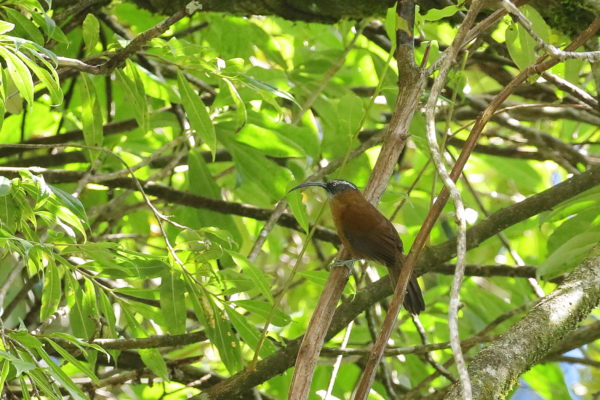
Slender-billed Scimitar Babbler
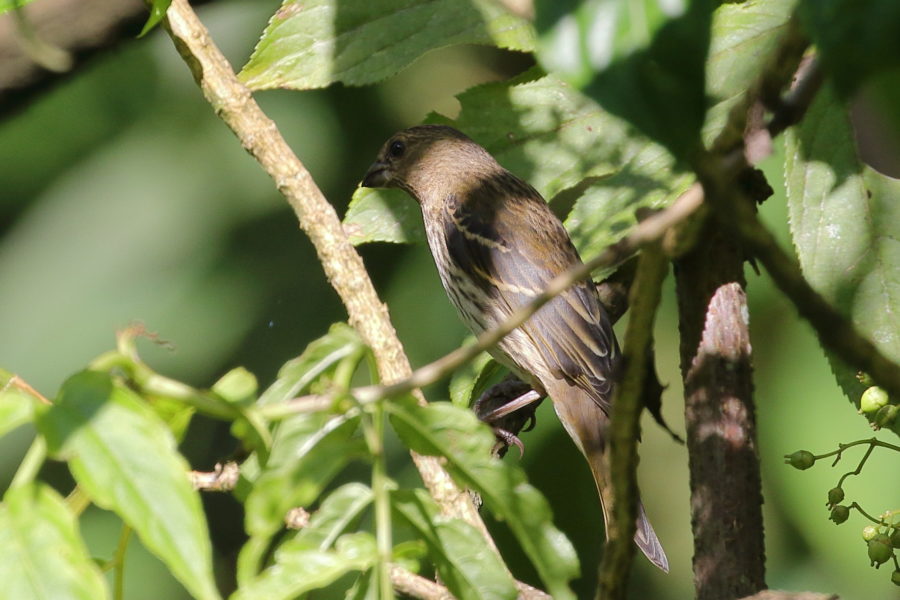
Common rosefinch (Female)
We had a deadline to catch at the ghat and time was very precious that day, with nary a moment to lose. Reaching Tiwarigaon, we gulped down ‘brunch’, this time with bread and instant noodles prepared by Didi, with me getting the chilly-less portion, as I had a penchant for running behind the bushes with toilet paper in a deadman’s grip.
Bituda must have been pleased when we promised to each other that this is the last birding for the day, as time was slipping fast. But a few meters down the road, Anupam sighted a red faced liocichla, and we scampered down, giving two hoots to our just mouthed promises. Except the discoverer, all the others missed out on the rarity but were comforted by a wide variety of feathery wonders – golden babbler, golden-throated barbet, lesser yellownape, mountain bulbul, assortment of warblers, common rosefinch, streaked spiderhunter, verditer flycatcher, striated bulbul and that ubiquitous herald of feeding flocks, the squirrel.
We ran into luck further down again when we thought we had espied a pied bushchat. But it turned out to be grey bushchat. Suddenly a flock of black throated tits came rummaging through the leafy trees accompanied by a juvenile black throated sunbird.
A last birding stop was at the potential habitat of the lesser parrotbill, a much sought after species for Swapnanil whose yearning inclined us to stop. But the blazing sun, rumblings of large road building vehicles and presence of crowds of workmen and their overseers in addition to the modified topography dented any chance of parrotbill sighting. A lone blue throated barbet was the terminal species of the trip.
Maintaining very perfect timing Bituda drove us into Roing by 2 pm and Ravi took our leave. We continued onwards, tired and cheerful till we reached the Sadiya ghat at ten minutes past 3pm. But our haste seemed in vain as only the last ferry was available, departing at 5:30 pm, all the other afternoon ferries being reserved by a group celebrating matrimonial alliance. No amount of coaxing and pleading could change the ferry crew’s decision and we resigned to our lot. Again, passed the time by having our lunch at the eatery by the ghat. The absence of roads or any permanent construction belied the fact that this was almost the sole and shortest communication to mainland Assam from the hinterland of Sadiya and the place was appropriately busy with quite a lot of traffic rolling over the road-less riverbank. It was also a tragic sight as the present ghat was actually a paddy-filed last pre-monsoon when a large swath of land was eroded by the river Kundil in the last floods, as testified by Anupam and Bituda who are rather frequent travellers to these parts. The one day old waning moon rose from the eastern horizon and darkness fell as our boat lifted anchor. A smallish boat, it barely spanned the wheelbase of our Scorpio car. A long route to avoid the shallows led to an almost one and half hour journey till we reached Dhola ghat in total darkness. The debarking of the vehicles from the ferry onto the sand bank is a chapter on itself. Suffice it is to say that Bituda did a very commendable job. Reaching the opposite bank had a sobering effect as home was only three hours journey away in a comfortable car.
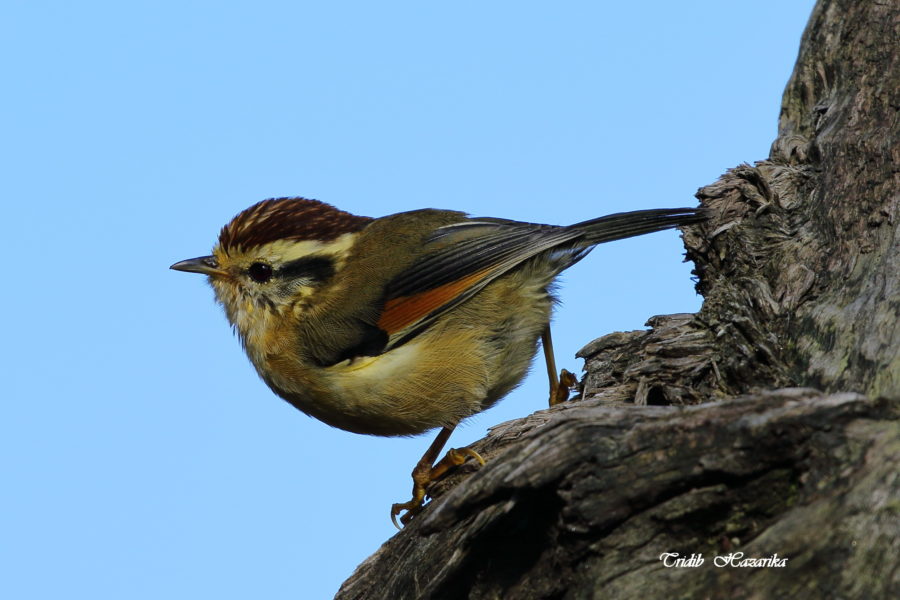
Rufous-winged Fulvetta
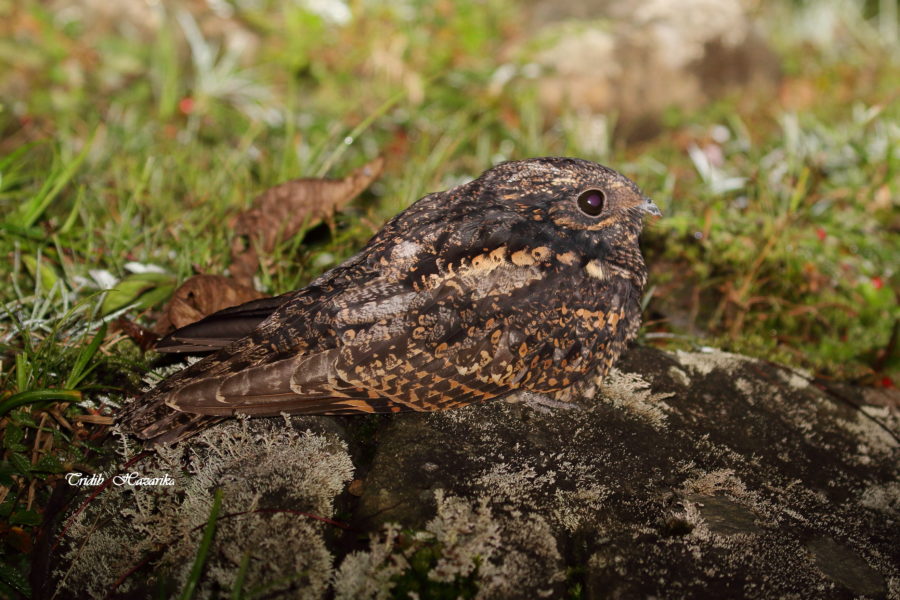
Grey nightjar
Bituda pointed out nightjars, caught in the headlights, dipping low in their quest for meals at the site of the under construction bridge. Somewhere near, an owl hooted. The last three days had been a hectic time with finger on the trigger alertness prevailing at almost all waking moments. We saw a lot, took photos to heart’s content and fed our thirst of birding. But did we have our fill? Probably not; as this thirst seems insatiable, calling us back again. Like that beefy actor from Hollywood would say, ‘I Will Be Back!’
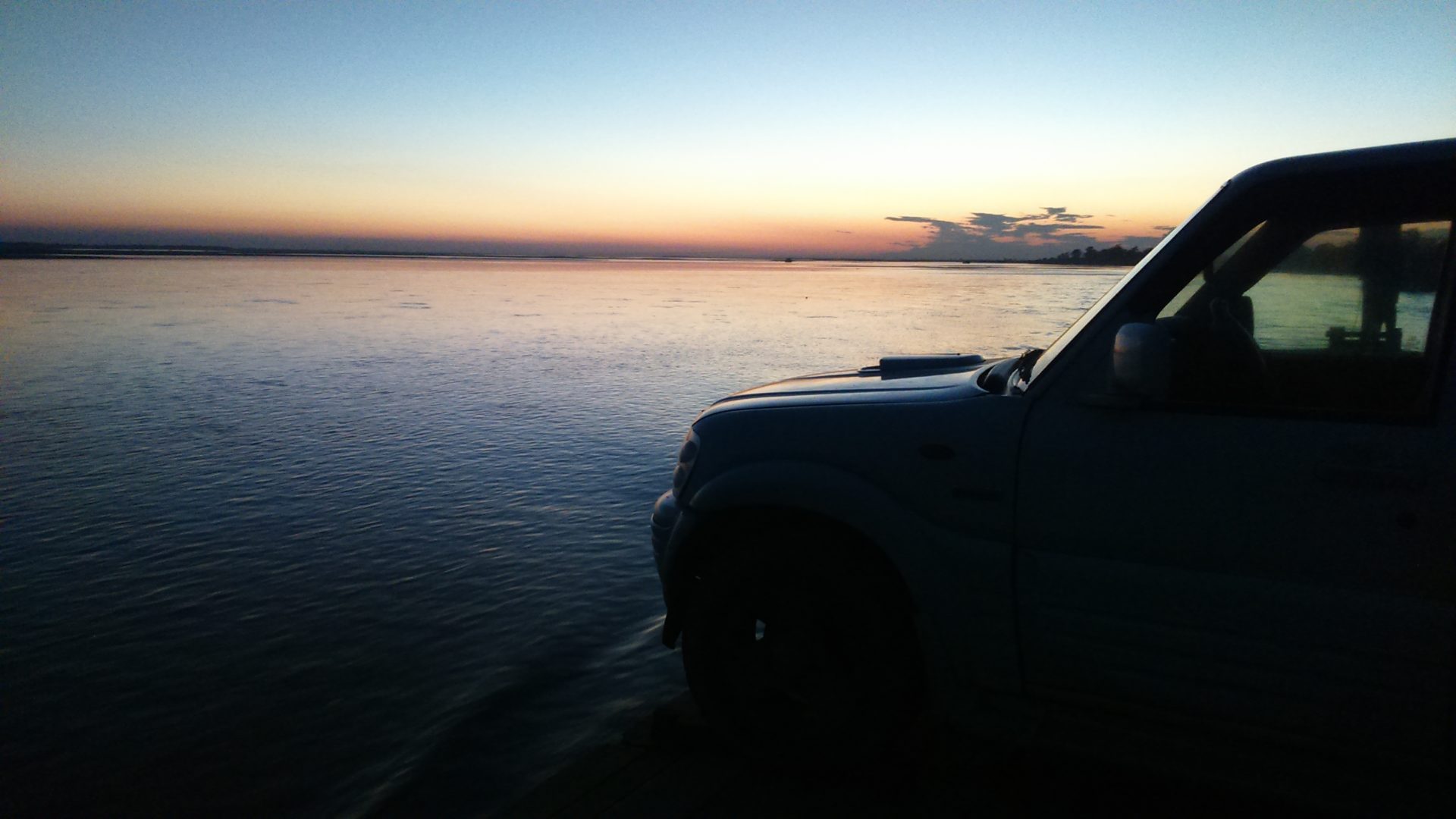
On the way home via river route
Team members :
Anupam Nahardeka
Swapnanil Borah
Tridib Hazarika
Bitu Das (Driver)
P.S. – This trip took place before the Dhola-Sadiya bridge was completed and hence used the Dhola ghat river route via the Lohit and Kundil rivers.
Trip List :
14 th to 16th October, 2016 | Mishmi Hills via Dhola ghat.
Hill partridge (H)
Blyth’s tragopan
Straited Heron
Indian Pond Heron
Intermediate Egrate
Cattle Egrate
Little Cormorannt
Common kestrel
Oriental Honey Buzzard
Medium sized Raptor (U)
Black Winged Kite
Slender Billed Vulture
White breasted waterhen
Emerald dove
Wedge-tailed green pigeon
Mountain imperial pigeon
Himalayan wood owl
Grey nightjar
Ward’s trogon (H)
Indian roller
White-throated kingfisher
Common kingfisher
Great barbet
Golden-throated barbet
Blue-throated barbet
Speckled piculet
Darjeeling woodpecker
Lesser yellownape
Blue-naped pitta (H)
Ashy woodswallow
Common woodshrike
Scarlet minivet
Long-tailed shrike
Black drongo
Ashy drongo
Maroon oriole
Black-hooded oriole
White-throated fantail
Yellow-bellied fantail
Grey treepie
Jungle crow
Yellow-cheeked tit
Great tit
Black-throated tit
Yellow-browed tit
Striated bulbul
Red-whiskered bulbul
Red-vented bulbul
Mountain bulbul
Rufescent prinia
Ashy-throated warbler
Whistler’s warbler
Black-faced warbler
Blyth’s leaf warbler
Broad-billed warbler
Grey-cheeked warbler
Tickell’s leaf warbler
Lemon-rumped warbler
Pygmy wren babbler
Bar-winged wren babbler
Manipur wedge billed babbler
Long billed wren babbler
Golden babbler
Coral billed scimitar babbler
Slender-billed babbler
Greater necklaced laughingthrush
White-crested laughingthrush
Blue-winged laughingthrush
Grey-sided laughingthrush
Chestnut crowned laughingthrush
Striated laughingthrush
Rusty fronted barwing
Streak-throated barwing
Red faced liocichla
Bar-throated siva
Black-eared shrike babbler
Silver eared mesia
Yellow throated fulvetta
Golden-breasted fulvetta
Rufous-winged fulvetta
Manipur fulvetta
Brown-throated fulvetta
Longtailed sibia
Beautiful sibia
Striated yuhina
White-naped yuhina
Rufous-vented yuhina
Greater rufous headed parrotbill
Black throated parrotbill
White-tailed nuthatch
Common mynah
Asian pied starling
Jungle mynah
Lesser shortwing (F)
White-browed shortwing (F)
White-capped water redstart
Common stonechat
Grey bushchat
Verditer flycatcher
Hill blue flycatcher
Grey headed canary flycatcher
Dark-sided flycatcher
Rufous-gorgeted flycatcher
Sapphire flycatcher
Small niltava (F)
Large niltava (F)
Blue winged leafbird
Fire-breasted flowerpecker
Black throated sunbird (E)
Green tailed sunbird
Streaked spiderhunter
Eurasian tree sparrow
White wagtail
Grey wagtail
Olive backed pipit
Common rosefinch
** Abbreviations : U – Unidentified; H – Heard Only; F – Female; E – Eclipse
Author's Details:

Tridib Hazarika
A wildlife photographer and a bird lover from the historic town of Dibrugarh in Assam. Though by profession he is a Radiologist the abundance of natural beauty in this part of the world has made him passionate about wildlife.At home he is a responsible father of two cute daughters, a caring husband and an adorable son.





Worth reading. Keep it up dada.
I am glad to be a visitor of this arrant website! , thanks for this rare info ! .